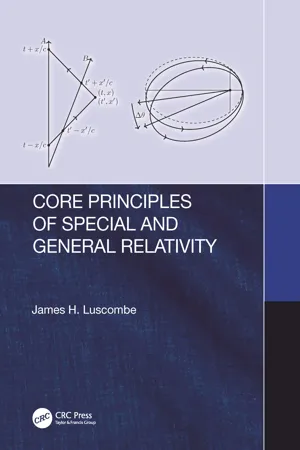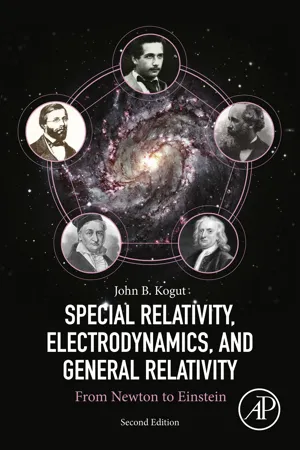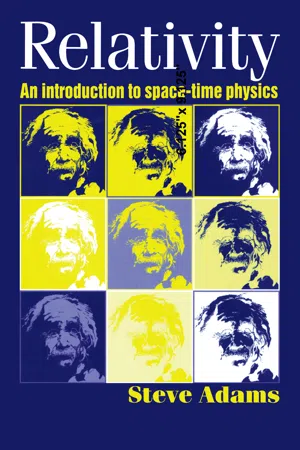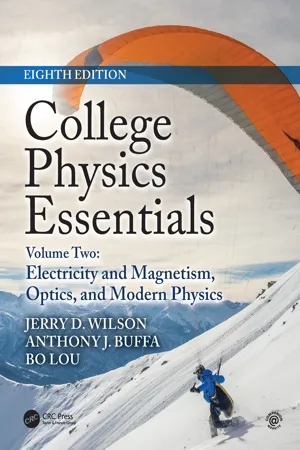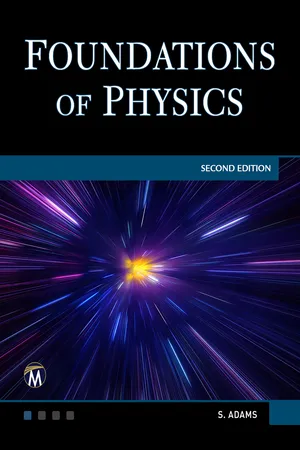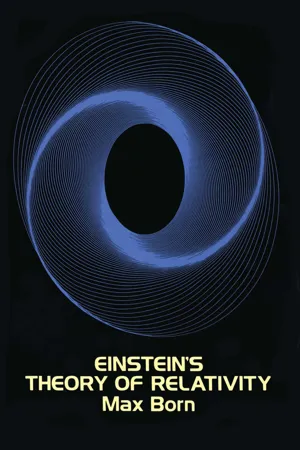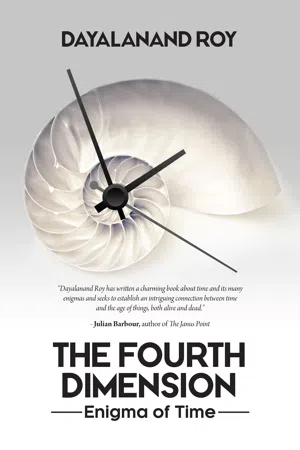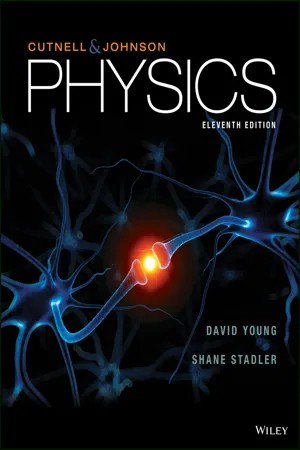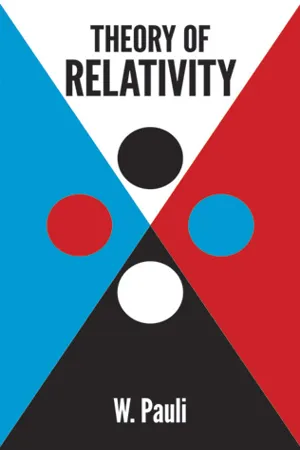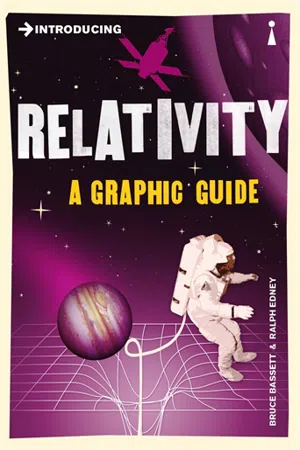Physics
Length Contraction
Length contraction is a phenomenon in special relativity where an object's length appears shorter when it is moving at a significant fraction of the speed of light relative to an observer. This effect is a consequence of the time dilation and space contraction that occur at high velocities, as described by Einstein's theory of special relativity.
Written by Perlego with AI-assistance
Related key terms
Related key terms
1 of 4
Related key terms
1 of 3
11 Key excerpts on "Length Contraction"
- James Luscombe(Author)
- 2018(Publication Date)
- CRC Press(Publisher)
Elementary particles can be made to move rapidly (speeds comparable to c), but their linear dimensions cannot be measured directly, while macroscopic objects, the dimensions of which can be measured, cannot be made to move at relativistic speeds. The predictions of SR all emerge from the principle of relativity, and Length Contraction is one of its consequences. It’s often said that SR rests on two postulates (the way Einstein presented it): the principle of relativity and the invariance of the speed of light in IRFs. The principle of relativity alone predicts a universal speed, which experiment shows to be the speed of light. 12 Time dilation has been confirmed through the measurement of the relativistic Doppler effect (Ives-Stillwell experiment [ 14 ]). The MM experiment [ 15 ] showed that the speed of light is isotropic, used in the derivation of the radar method. The Kennedy-Thorndike experiment [ 16 ] showed that the speed of light is independent of the velocity of the source, implicitly used in the derivation of each of the effects of SR (Doppler effect, time dilation, Lorentz transformation, Length Contraction). While there is no direct confirmation of Length Contraction, we show in Chapter that the Lorentz force q (E + v × B) can be derived without approximation as a frame transformation, a derivation that relies heavily on Length Contraction. 2.5.7 Length Contraction in one frame is time dilation in another Time dilation and Length Contraction are each a consequence of the relativity of simultaneity. Both effects emerge from a comparison of events measured from reference frames in relative motion. In a frame at rest relative to clocks and rods, measurements taken at the same location (proper time) and at the same time (proper length), are different from measurements made in a frame in which clocks and rods are in motion, the measurements of which occur at different locations (time dilation) and at different times (Length Contraction)- eBook - ePub
Special Relativity, Electrodynamics, and General Relativity
From Newton to Einstein
- John B. Kogut(Author)
- 2018(Publication Date)
- Academic Press(Publisher)
o /γ! This is indeed the case. The effect is called Lorentz contraction, named after the physicist who first deduced the effect in the context of the theory of electricity and magnetism at the very beginning of the 20th century. We look more closely at this important effect in the next section.2.3. Lorentz Contraction
If the constancy of the speed limit implies time dilation, it must also affect the measurements of lengths of moving objects. This effect, called Lorentz contraction, is also easily obtained from Einstein's clock.To begin, take the clock at rest in frame S ′ and rotate it by 90 degrees so that its length ℓ o is parallel to v , the relative velocity of the second frame S . It is conventional to call ℓ o the proper length of the clock because this is its length in the frame in which it is at rest. Because space is homogeneous in an inertial frame, the rotated clock works as it did before. In frame S ′, we had Δτ = 2ℓ o /c . As before, this proper time interval Δτ must be dilated when measured in frame S because the rotation of the clock cannot affect its internal workings. But now view the path of the light ray in the frame S , as shown in Fig. 2.4 .We label the length of the clock, from A to B, as measured in frame S as ℓ . In the first image of Fig. 2.4 , light leaves the mirror and heads toward mirror B. In the second image, the light ray reaches mirror B after a time Δt 1 . The mirror A has moved a distance v Δt 1 to the right, soc Δt 1= ℓ + υ Δt 1.(2.7)Figure 2.4 The rotated clock viewed from frame S .In the third image of Fig. 2.4 , the light that left mirror B reaches mirror A and is reflected. Between images 2 and 3, a time Δt 2 has passed in frame S , so the mirror A moves an additional distance v Δt 2 - eBook - ePub
Relativity
An Introduction to Spacetime Physics
- Steve Adams(Author)
- 2017(Publication Date)
- CRC Press(Publisher)
• Just like time dilation this is a reciprocal effect. A sees B's rod contract, B sees A's rod contract. There is no paradox here because, in order to make a genuine comparison of the rod lengths we should have to put them both into the same reference frame, that is bring rod A to rest in B's frame or bring rod B to rest in A's frame. In either case this would remove the very effect we are discussing which arises only when there is relative motion between the two systems.• Each observer sees no change in the lengths of objects in their own reference frame. It is the scale of length as judged by an external moving observer that has changed, and then only in the direction of motion.• Since Length Contraction only affects dimensions parallel to the direction of motion the shape of a moving object changes too. For example, if we passed the Sun at high enough speed, its diameter parallel to our direction of motion would contract: it would appear as an ellipse with its major axis perpendicular to the direction of our relative motion.• As mentioned previously, we do not have to measure the length of a rod to demonstrate Length Contraction. If there is a star one hundred light years from Earth then, merely by travelling rapidly towards it, the journey length contracts and we do not have so far to travel. For example, at 0.99995c (7 = 100) the journey distance would contract to just one light year and the journey time (for the traveller) would be a shade over a year. Of course, a little over one hundred years would pass on Earth before the traveller completed his outward bound journey.• The length of a rod measured in its rest frame is called its proper length. Similarly, the time between two events measured on a clock which coincides with both events is called the proper time. The measured length of a rod never exceeds its proper length and the measured time between two events is never less than the proper time.Example - eBook - ePub
College Physics Essentials, Eighth Edition
Electricity and Magnetism, Optics, Modern Physics (Volume Two)
- Jerry D. Wilson, Anthony J. Buffa, Bo Lou(Authors)
- 2019(Publication Date)
- CRC Press(Publisher)
o .▲ Figure 26.7 Derivation of Length Contraction expression The observer in O measures the time it takes for the observer in O ′ to move past the ends of the rod. Similarly, the observer in O ′ measures the time it takes for the ends of the rod to pass her. The observer in O ′ is the proper time measurer ; she measures the shortest possible time between these two events. The measured lengths of the rod are not the same. The observer in O is the proper length measurer; he measures the longest possible length.Suppose the observer in O measures the rod’s length using the same method. To him, the observer in O ′ is moving relative to the rod. If he notes the times on his clock when O ′ passes the ends of the rod, he measures a time interval Δ t . For him, the length of the stick is the proper length; therefore, L o = v Δ t . Then, dividing one length by the other yieldsL=L o=v Δt ov Δ tΔt oΔ t(26.6) But Δ t = γ Δ t o (Equation 26.5), or Δ t o /Δ t = 1/γ . Thus Equation 26.6 can be rewritten asL ==L oγL o1 −( relativistic length contraction )( v / c )2(26.7) Since γ > 1, then, as expected, L < L o . This is called relativistic Length Contraction .To see the effects of Length Contraction and time dilation, consider the following two high-speed Examples. Example 26.3: Warp Speed? Length Contraction and Time DilationAn observer sees a spaceship, 100 m long when at rest with respect to her, pass completely by (i.e., nose to tail) at a speed of 0.500c (▶ Figure 26.8 - eBook - ePub
- Steve Adams(Author)
- 2023(Publication Date)
- Mercury Learning and Information(Publisher)
= 5 years.If the observers on board the space craft work out the distance they have traveled, it will be 5 (v /c ) light years rather than the 100 000 (υ /c ) light years as observed from the Earth. The distance traveled has contracted by the same gamma-factor as the time. This is an example of relativistic Length Contraction.The Length Contraction formula is:L is the length of an object measured in its rest frame: its “proper length.”L ’ is the length of the same object when it moves past the observer at velocity υ .24.4 THE LORENTZ TRANSFORMATIONLength Contraction, the relativity of simultaneity, and time dilation, all show that measurements of time and space in one inertial reference frame will not agree with measurements in another inertial reference frame in relative motion. The Lorentz transformation equations relate the coordinates of an event in one inertial reference frame to the coordinates of the same event in another inertial reference frame moving at constant velocity with respect to the first.24.4.1 The Lorentz Transformation EquationsFor simplicity, we will define our axes so that the relative motion is along the x axis, so that the y and z coordinates are not affected by the motion.The diagram above shows the coordinate systems used in two inertial reference frames. The primed frame is moving at velocity v in the positive x - and x ’-direction. At time t = 0 the origins of both coordinate systems coincide. An event with coordinates (x , y , z , t ) in the unprimed frame has coordinates (x ’, y ’, z ’, t - eBook - ePub
- Max Born(Author)
- 2012(Publication Date)
- Dover Publications(Publisher)
Fig. 119 Lorentz contraction.Now its length is to be determined in the system S′(x′t′) which is moving with respect to S. Thus its ct′-axis is inclined to the ct-axis. We find the corresponding x′-axis by drawing the tangent at the point of intersection Q′_of the ct′-axis with the calibration curve and then draw the parallel to this tangent through O. The distance is the unit of length on the x′-axis. The length of the rod of unit length at rest in the system S as measured in the system S′ is, however, determined by the distance which the parallel strip representing the rod cuts out of the x′-axis. This is clearly shorter than , thus is less than 1, and hence the rod appears shortened in the moving system S′.This is exactly the contraction devised by Fitzgerald and Lorentz to explain Michelson and Morley's experiment. Here it appears as a natural consequence of Einstein's kinematics.If, conversely, a rod at rest in the system S′ is measured from the system S, it likewise appears contracted and not lengthened. For such a rod is represented by the strip which is bounded by the ct′- axis and the world line parallel to it through the point P′. But the latter meets the unit distance of the system S in an internal point R, so that is smaller than 1.Thus the contraction is reciprocal, and this is what the theory of relativity demands. Its magnitude is best found with the help of the Lorentz transformation (70).Let l0 be the length of the rod in the system of reference S′ in which it is at rest; l0 is called the statical length or proper length of the rod. The two ends of the rod may be at the points x1 and x2 ′ then x2 ′- x1 ′ = l0 .If the rod is observed in S, we have from the first formula of (70a)where x1 t1 and x2 , t2 are the coordinates of x1 ′ and x2 ′ in S. Now we wish to measure the length of the rod in S that means we must determine the coordinates x1 and x2 simultaneously with regard to S: we must set t1 = t2 - eBook - ePub
Scientific Thought
A Philosophical Analysis of some of its fundamental concepts
- C.D. Broad(Author)
- 2014(Publication Date)
- Routledge(Publisher)
Local Times , because they vary with the position of the clocks on the platform, even when the absolute time is the same.It is usual, for convenience, to denote the fraction by k . We can then say that the Lorentz-Fitzgerald Contraction means that a measured length x in the direction of motion of the platform represents a physical length of only x/k . And the equation just reached tells us that the absolute time is connected with the local time of a clock on a moving platform by the formula assuming that the clocks have been set by light signals according to the conventions laid down on p. 129. We want one more equation before we can get any further. Suppose that when the standard clock on the platform marked O it was opposite to a point α in Absolute Space. When the clock B markstBlet that clock be opposite to a point β of Absolute Space. The co-ordinate of β, in the direction of motion of the platform and relative to the platform, will of course simply bexB, the distance as measured along the platform in this direction from the standard clock to the clock B. How will this be related to Xβ , the Space between the point β and the point α, which the standard clock was opposite to at the beginning? The diagram above will illustrate the problem.We have two factors to consider. (1) Owing to the Lorentz-Fitzgerald Contraction the measured lengthxBonly represents a physical lengthxB/k . (2) The platform has moved through the ether for the physical time-lapse that corresponds to the local timetB. If this lapse be t the platform has moved a physical distance vt . But, by equation (1), . Hence This is the other fundamental equation of the subject, for it connects the physical distance of two points in Absolute Space with the measured magnitude of their co-ordinates relative to a moving platform . The k factor enters through the Contraction and the Local Time, the V - eBook - ePub
The Fourth Dimension
Enigma of Time
- Dayalanand Roy(Author)
- 2021(Publication Date)
- BrownWalker Press(Publisher)
Thus, we see that Einstein’s Special Theory of Relativity makes certain predictions about time. First of all it says that two events which are simultaneous for an observer standing nearby may not be simultaneous for another observer who is moving at a fast speed. Then it says that time delays for a moving object- the faster it moves; the slower becomes the time for it. In other words, time dilates during movement; it is not absolute.In this way, theory of relativity made a revolution in our concept of time. Though it passed all the tests it faced, yet it seemed to be counter-intuitive to many people. A non-physicist can hardly conceptualize how time can slow down. He knows that a moving train can be slowed down, a moving car can be slowed down; but by these facts he simply apprehends that, when slowed, the train or the car will move lesser distance in given time- say an hour. But he is just unable to apprehend how time can be slowed. Is it like a train or car? More so, the one hour duration is quite fixed in his mind. It is difficult for him to conceptualize that this one hour too can be different for different persons. We shall try to conceptualize it in the light of the model of time we have proposed here.Let us consider a little deeply the question- why should moving clocks record a time different from that recorded by a stationary clock; why should the time read by different clocks placed in different reference frames not necessarily agree with one another?The model of time adopted here presents a probable solution to these questions. We have defined time as the fourth dimension of objects- a measurement of their fourth dimension, their extension into fourth dimension . Special relativity says that length contracts and time dilates during motion. Length is a dimension of the moving object and it contracts. So, when time dilates during motion, why should it not be a dimension of the moving object too? I think, of course, it could be. ‘When something moves at a high speed, its time dilates’- this statement, I propose, simply means, while moving at a high speed, it acquires less fourth dimension, less age .We have discussed in chapter four what a clock is as per our definition of time. Clocks too, like any other object, age and thus extend into their fourth dimension that is marked as seconds, minutes, hours, etc.—these markings are the time stones of a clock, reading one second, two seconds … . one minute, two minutes …. etc.—just as the spatial extension of a road is marked with milestones , reading one mile, two miles … etc.; or the markings of a measuring scale reading one millimeter, two millimeters etc. A tree grows and acquires height; and we can mark its different heights- one meter, two meters … eleven meters etc. Along with acquiring the height, it acquires age too. And often, its age too is ‘self-marked’ by formation of annual rings in its stem. We can roughly count its age with the help of these rings- one year, two years …. eleven years, etc. A clock also ages and is equipped to ‘self-mark’ its own age (or, its own fourth dimension) - eBook - ePub
- John D. Cutnell, Kenneth W. Johnson, David Young, Shane Stadler(Authors)
- 2018(Publication Date)
- Wiley(Publisher)
These concepts are time, length, momentum, kinetic energy, and the addition of velocities. We will see that each is modified by special relativity in a way that depends on the speed v of a moving object relative to the speed c of light in a vacuum. Figure 28.3 illustrates that when the object moves slowly [ v is much smaller than c (v ≪ c) ], the modification is negligibly small, and the classical version of each concept provides an accurate description of reality. However, when the object moves so rapidly that v is an appreciable fraction of the speed of light [ v is approximately equal to c (v ≈ c) ], the effects of special relativity must be considered. The gold panel in Figure 28.3 lists the various equations that convey the modifications imposed by special relativity. Each of these equations will be discussed in later sections of this chapter. FIGURE 28.3 Albert Einstein (1879–1955), the author of the theory of special relativity, is one of the most famous scientists of the twentieth century. This figure emphasizes that the ratio v / c of the speed v of a moving object to the speed c of light in a vacuum is what determines how great the effects of special relativity are. It is important to realize that the modifications imposed by special relativity do not imply that the classical concepts of time, length, momentum, kinetic energy, and the addition of velocities, as developed by Newton and others, are wrong. They are just limited to speeds that are very small compared to the speed of light. In contrast, the relativistic view of the concepts applies to all speeds between zero and the speed of light. 28.3 The Relativity of Time: Time Dilation Time Dilation Common experience indicates that time passes just as quickly for a person standing on the ground as it does for an astronaut in a spacecraft. In contrast, special relativity reveals that the person on the ground measures time passing more slowly for the astronaut than for herself - eBook - ePub
- W. Pauli(Author)
- 2013(Publication Date)
- Dover Publications(Publisher)
2 ) : 1, as was already assumed by Lorentz. Since the transverse dimensions of a body remain unaltered, the same formula applies to the contraction of its volume:We have seen that this contraction is connected with the relativity of simultaneity, and for this reason the argument has been put forward36 that it is only an “apparent” contraction, in other words, that it is only simulated by our space-time measurements. If a state is called real only when it can be determined in the same way in all Galilean reference systems, then the Lorentz contraction is indeed only apparent, since an observer at rest in K' will see the rod without contraction. But we do not consider such a point of view as appropriate, and in any case the Lorentz contraction is in principle observable. In this connection a “thought experiment” of Einstein’s37 is instructive. It shows that the determination of the simultaneity of spatially separated events, which is necessary for the observation of the Lorentz contraction, can be carried out entirely with the help of measuring rods, without the use of clocks. For let us think of using two rods A1 B1 and A2 B2 of the same rest length l0 , which move relative to K with equal and opposite velocity υ. We mark the points A* and B* in K at which the points A1 and A2 and B1 and B2 , respectively, overlap. (For reasons of symmetry the overlappings take place simultaneously in K.) The distance A*B*, as measured by rods at rest in K, will then have the valueIt therefore follows that the Lorentz contraction is not a property of a single measuring rod taken by itself, but is a reciprocal relation between two such rods moving relatively to each other, and this relation is in principle observable.Analogously, the time scale is changed by the motion. Let us again consider a clock which is at rest in K'. The time t' which it indicates in K' is its proper time τ and we can put its coordinate x' - eBook - ePub
Graphic Guides
A Graphic Guide
- Bruce Bassett, Ralph Edney(Authors)
- 2014(Publication Date)
- Icon Books(Publisher)
H.A. Lorentz (1853–1928) is a crucial example.YOUR TRANSFORMATIONS WERE A PATH TO MY SPECIAL RELATIVITYIMAGINE YOU STAY STILL...... AND I MOVE WITH VELOCITY vTHIS CAN BE SHOWN ON A SPACE-TIME DIAGRAMc, THE SPEED OF LIGHT, IS THE SAME FOR BOTH OF US AND THE DISTANCE MEASURED BY YOU & ME IN SPACE AND TIME WILL ALSO BE THE SAME, OR INVARIANTThe remarkable result of special relativity is that it shows how our ordinary intuition about relative motion fails when one is moving near the speed of light, approximately 300,000 km per second. The speed of light is a fundamental constant which in Einstein’s theory is independent of the speed of the observer.I CLAIMED – AND WAS LATER PROVEN TO BE CORRECT – THAT OBSERVED LENGTHS, TIME & ENERGIES ALL BECOME SIGNIFICANTLY WARPED WHEN SPEEDS APPROACH CKEEP IN MIND THAT SPECIAL RELATIVITY APPLIES IN ANY SITUATION WITHOUT GRAVITY AND WITHOUT ACCELERATIONI’M ALICE AND THIS IS BOB-AS OBSERVERS WE’LL HELP EXPLAIN THESE EFFECTSThe Effect of Length Contraction
Alice and Bob are moving at a constant speed, v , relative to each other. How does Alice see Bob?Alice sees the length as shorter than Bob sees it.THE RULER MEASURES LENGTH L IN THE DIRECTION ON MY MOTION...I ACTUALLY SEE THIS LENGTH SHRINK DUE TO OUR RELATIVE MOTIONI SEE IT ASTime Dilation
Similarly, we find that the rates at which time flows are different for observers moving relative to each other. But is time slowed down or sped up by moving faster?THE TIME ON BOB’S CLOCK IS GIVEN IN TERMS OF MY CLOCK AS...AS I MOVE CLOSER & CLOSER TO THE SPEED OF LIGHT MY CLOCK PROGRESSIVELY SLOWS DOWN RELATIVE TO ALICE’SHowever, even to get Bob’s time to flow at half the rate of Alice’s, he must move at around 86% the speed of light. So it is not an issue for life on earth. However, time dilation has actually been observed, as we’ll next encounter.Observing Muons
Cosmic rays travel from outer space and hit the atmosphere at nearly the speed of light. The collision creates muons
Index pages curate the most relevant extracts from our library of academic textbooks. They’ve been created using an in-house natural language model (NLM), each adding context and meaning to key research topics.
Explore more topic indexes
Explore more topic indexes
1 of 6
Explore more topic indexes
1 of 4
